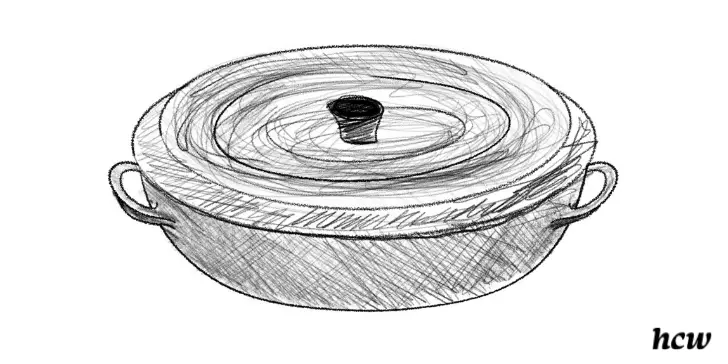Know your cookware. The differences between a sauté pan and a sauteuse are subtle but important. So here’s a guide to them.
There was a time in my life when the only cooking vessel I needed was the non-stick frying pan in the dorm’s common kitchen.
That was what feels like an eternity ago. And since, I’ve come to appreciate the suble idiosyncrasies between one piece of cookware and another.
Nowhere are these idiosyncrasies more subtle than in the world of French cookware—where the names, the shapes, and very often the uses of cooking vessels can be confusingly similar.
Since you’re here and you’re reading this article, I take it you’ve found yourself in the same situation. Namely, you’re wondering about the difference between a sauté pan and a sauteuse pan. So let’s waste no time and get right into it.
What Is a Sauté Pan?

A sauté pan is a frying pan with a large surface; tall, straight sides; a long, sturdy handle; and a tight-fitting lid. Most sauté pans also have a helper handle for easy transfer from the stovetop to the oven.
The sauté pan takes its name from the French verb “sauter,” which means to bounce or to jump. Chefs use this type of pan by swirling and tossing the food side to side inside the vessel and back and forth into the air as it sizzles over high heat.
To use a sauté pan, hold it by the handle with your dominant hand. Your non-dominant hand is for stirring and flipping the food, gripping the helper handle, and lifting or closing the lid as needed during cooking.
Sauté pans are most helpful for dry-heat cooking methods, such as searing steak and sautéing mushrooms, for wet-heat cooking methods, such as simmering down a sauce, as well as for combination cooking methods, such as preparing a braise.
What Is a Sauteuse Pan

A sauteuse pan is part Dutch oven, part sauté pan, and part wok. It’s intended to be used on the stovetop and in the oven and has tall, sloping sides and two equally sized side handles.
In French, “sauteuse” is the feminine of “sauter.” The name of this cooking vessel suggests a more gentle, hands-off way of preparing food than the hasty, hands-on use of a sauté pan over a hot burner.
To use a sauteuse pan, place it on the stove or slide it into the oven and follow the instructions of the recipe. Unlike a sauté pan, whose extended handle allows the cook to swirl and toss the food as needed, a sauteuse pan is meant to remain immobile during cooking.
A sauteuse pan is most convenient for browning meat and caramelizing vegetables. However, thanks to its large capacity, it is also excellent for preparing stews, shallow or deep-frying à la minute dishes, and making casseroles.
Sauté Pan vs. Sauteuse Pan
Say you already own a good skillet and you want to expand your cookware collection, but you’re not quite sure whether you should get a sauté pan or a sauteuse pan first.
How do you decide which piece of cookware to get?
If you’re looking for a pan that’s more like a skillet, but better for simmering sauces and preparing braises without sploshing everything out on the stove, consider a sauté pan.
If, on the other hand, you want a pan in which you can sear meat and sauté vegetables, as well as make casseroles and bake bread, you may be better off going for a sauteuse.
